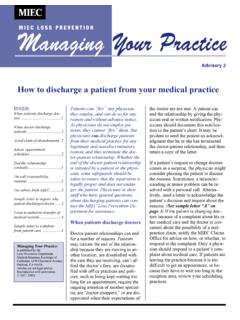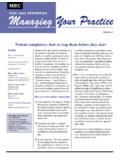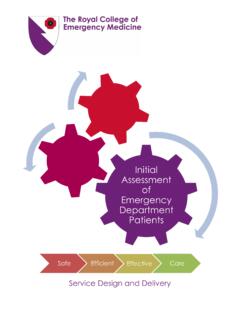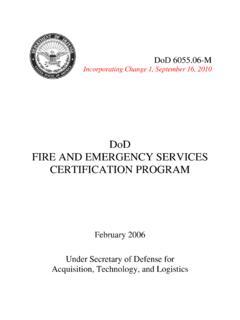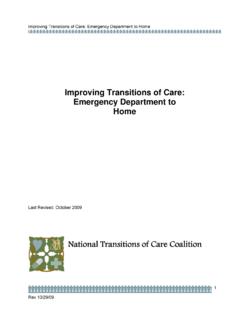Transcription of Reduce Your Risks in the Emergency Department
1 MIECR educe Your Risks in the Emergency DepartmentMedical Insurance Exchange of CaliforniaClaremont Liability Insurance CompanyMedical Underwriters of Californiamanagement companyProtective Policies and ProceduresInterdepartmental Risk Reduction Clear CommunicationOptimal DocumentationFurther Decreasing Liability RisksTable of ContentsHow to Reach MIEC 20 Resources 21 Bibliography 23 Reduce Your Risks in the Emergency Department is a publication of MIEC s Loss Prevention Department . The authors have conducted numerous Emergency Department (ED) surveys and have reviewed thousands of ED records.
2 Each of the authors has extensive experience in medical malpractice claims management and loss prevention activities on behalf of physicians and other health professionals. Recommendations to Reduce Emergency Department risk are based on the authors analysis of Emergency Department policies, discussions with ED physicians and nurses, review of ED records and malpractice litigation files. They include advice from malpractice defense attorneys, claims experts and physicians whose involvement in peer review activities gives them a unique understanding of Emergency reproduction without permission.
3 Copyright 2005, Medical Insurance Exchange of California, Oakland, Your Risks in the Emergency Department RECOMMENDATIONs FOR ..Protective Policies and Procedures 3 Interdepartmental Risk Reduction 8 Clear Communication 11 Optimal Documentation 14 Further Decreasing Liability Risks 17 Reduce YOUR Risks IN THE Emergency DEPARTMENTE mergency physicians face daily challenges that few other specialties encounter: They must establish rapport with patients they may never seen again, diagnose and treat urgent and emergent conditions that require immediate care, and accomplish both under circumstances that range from unpredictable and uncomfortable, at best, to life-threatening.
4 Patients, especially those disenfranchised from optimal access to health care, use the Emergency Department (ED) for primary care with increasing frequency. In addition, Emergency personnel must contend with victims of violence who may bring a measure of that violence with them to the ED. When things go awry, when Emergency care can t solve all the patient s problems, when a patient is injured or perceives that he/she has been injured, Emergency physicians often become a target of blame. This booklet highlights the basic tenets of loss prevention, which, if applied, will help Emergency physicians protect their patients and themselves.
5 These recommendations will help physicians prevent patient injuries and subsequent lawsuits, contribute to establishing and maintaining patient relations that protect both physicians and patients, and ensure that ED documentation will assist, rather than impede, the ED physician s defense in a medical malpractice FOR PROTECTIVE POLICIEs AND PROCEDUREs:1. Establish a comprehensive physician and nurse group physicians have the obligation to ensure that newly hired physicians and nurses have read, and also understand and agree to abide by group, departmental, and hospital policies and procedures.
6 Periodic re-orientation for physicians and nurses is also essential to refresh their comprehension of policies and to alert them to revisions they may not have addition to the day-to-day tasks that govern the Emergency Department , topics that should be considered in a new employee orientation include: n Availability, accessibility, special needs and/or requirements of other departments, such as radiology, laboratory, specialty units, ob/gyn, psychiatry, transportation, respiratory therapy, social services, and clergy;n How patients will be admitted to various hospital services;n Procedures for contacting consultants and specialists, what to do in the event of a conflict between the ED and other physicians, and how to document inter-professional and inter-departmental interactions;n How to handle in- Department crises, such as fires, natural disasters, equipment failures, and violence.
7 Medical Insurance Exchange of California3n What the hospital s media policy is, and who will respond to media in the event of celebrity care, disaster response, sensationalistic event, or other media interests;n A review of reporting requirements, to whom these reports must be made, and within what time frame (abuse, acts of violence, gunshot wounds, threats of harm, recurrent lapses of consciousness, contagious disease, dog bites, etc.);n Resources for referral of patients to social services, both within the hospital and externally (battered spouses, abused children or elders, indigent patients, rape survivors, psychiatric referrals, etc.)
8 ;n How to report and resolve problems and complaints within the Department and within the hospital;n OsHA, HIPAA, and EMTALA regulations;n Hospital policies related to the Americans with Disabilities Act and patients with limited English proficiency;n Resources for staff ( , inservice programs for licensure, impaired physician resources, etc.); n How and who will manage Codes within the hospital, where codes will be documented and by whom; andn Other policies and procedures necessary to safely and competently provide care in the good orientation program is completed by evidence of: (1) the process by which policies and procedures are distributed to employees, and (2) employee acknowledgment of their receipt of the information, confirmation that they have read it and understand it, and certification of the fact that they agree to follow it.
9 It is incumbent upon physician and nurse ED directors to participate in periodic reviews of policies and procedures. This serves a twofold purpose. It ensures that policies and procedures reflect the reality of the Department . It should lead to regular in-service education programs to ensure that all individuals working in the ED understand the policies and why they exist, and to re-emphasize the need to comply with Department requirements. It also provides an opportunity for ED staff to provide feedback to their Ensure that all Emergency Department personnel know how to prevent and handle patient complaints.
10 Policies that make sense, that are agreed upon by staff and risk management, and that clearly describe what to do to prevent complaints and what to do if a patient makes a complaint, help ensure fewer patient complaints and consistency in how complaints are , avoid patient complaints: n Treat patients with Communicate clearly what you are doing and Avoid surprises; tell patients what to expect, both with the patient information brochure (Figure 1) and by careful communication by all ED Apologize for delays and excessive waiting times without placing blame on any particular component of the ED experience ( , The doctor is so slow, We re understaffed, Those Reduce Your Risks in the Emergency Department4 Figure 1, page 1 Reduce Your Risks in the Emergency DepartmentFigure 1, page 2 laboratory people are always late.)

